Research on Village Type Identification and Development Strategy under the Background of Rural Revitalization: A Case of Gaochun District in Nanjing, China
Abstract
:1. Introduction
2. Materials and Methods
2.1. Study Area and Data Collection
2.2. Research Framework
2.3. Methods
2.3.1. Construction of Index System
- (1)
- Initial structure of index system
- (2)
- Simplification and finalization of the index system
2.3.2. Index Weight Calculation
2.3.3. Calculation Based on Polygon Area Method
3. Results
3.1. Result Analysis
3.1.1. Analysis of Village Development Level in Gaochun District
3.1.2. Analysis of Reconstruction Intensity of Villages in Gaochun District
3.2. Classification of Village Types
- (1)
- Characteristic protection villages
- (2)
- Urban-suburban integration villages
- (3)
- Agglomeration and upgrading villages
- (4)
- Improvement and development villages
- (5)
- Relocation and merger villages
4. Discussion
5. Conclusions
Author Contributions
Funding
Institutional Review Board Statement
Data Availability Statement
Acknowledgments
Conflicts of Interest
References
- Liu, Y.; Li, Y. Revitalize the world’s countryside. Nature 2017, 548, 275–277. [Google Scholar] [CrossRef] [PubMed]
- Grant, W. The Common Agricultural Policy; Macmillan Press Ltd.: London, UK, 1997; p. 48. [Google Scholar]
- Liu, Y. Research on the urban-rural integration and rural revitalization in the new era in China. Acta Geogr. Sin. 2018, 73, 637–650. [Google Scholar]
- Huang, Z. On the Strategy of Rural Revitalization in China. Chin. Rural. Econ. 2018, 4, 2–12. [Google Scholar]
- Li, Y.; Westlund, H.; Zheng, X.; Liu, Y. Bottom-up initiatives and revival in the face of rural decline: Case studies from China and Sweden. J. Rural. Stud. 2016, 47, 506–513. [Google Scholar] [CrossRef]
- Liu, Y.; Zhou, Y.; Li, Y. Rural regional system and rural revitalization strategy in China. Acta Geogr. Sin. 2019, 74, 2511–2528. [Google Scholar]
- Jia, K.; Qiao, W.; Chai, Y.; Feng, T.; Wang, Y.; Ge, D. Spatial distribution characteristics of rural settlements under diversified rural production functions: A case of Taizhou, China. Habitat Int. 2020, 102, 102201. [Google Scholar] [CrossRef]
- Demangeon, A. Humanistic Geography Problem; The Commercial Press: Beijing, China, 1993. [Google Scholar]
- Guo, Z.; Hong, L.; Qiao, J.; Paul, M. Rural classification in the UK and its enlightenment to China. City Plan. Rev. 2019, 43, 75–81. [Google Scholar]
- Marsden, T.; Cloke, P.; Mooney, P. The Handbook of Rural Studies; Sage: London, UK; Thousand Oaks, CA, USA; Delhi, India, 2006; pp. 3–17. [Google Scholar]
- Cloke, P. Changing patterns of urbanization in rural areas of England and Wales, 1961–1971. Reg. Stud. 1978, 12, 603–617. [Google Scholar] [CrossRef]
- Pini, B. Focus groups, feminist research and farm women: Opportunities for empowerment in rural social research. J. Rural. Stud. 2002, 18, 339–351. [Google Scholar] [CrossRef]
- Porta, J.; Parapar, J.; Doallo, R.; Barbosa, V.; Sante, I.; Crecente, R.; Diaz, C. A population-based iterated greedy algorithm for the delimitation and zoning of rural settlements. Comput. Environ. Urban Syst. 2013, 39, 12–26. [Google Scholar] [CrossRef]
- Tian, Y.; Qian, J.; Wang, L. Village classification in metropolitan suburbs from the perspective of urban-rural integration and improvement strategies: A case study of Wuhan, central China. Land Use Policy 2021, 111, 105748. [Google Scholar] [CrossRef]
- Cloke, P. An index of rurality for England and Wales. Reg. Stud. 1977, 11, 31–46. [Google Scholar] [CrossRef]
- Harrington, V.; O’Donoghue, D. Rurality in England and Wales 1991: A Replication and Extension of the 1981 Rurality Index. Sociol. Rural. 2010, 38, 178–203. [Google Scholar] [CrossRef]
- Woods, M. Performing rurality and practising rural geography. Prog. Hum. Geogr. 2010, 6, 835–846. [Google Scholar] [CrossRef]
- Qu, Y.; Jiang, G.; Zhao, Q.; Ma, W.; Zhang, R.; Yang, Y. Geographic identification, spatial differentiation, and formation mechanism of multifunction of rural settlements: A case study of 804 typical villages in Shandong Province, China. J. Clean. Prod. 2017, 166, 1202–1215. [Google Scholar] [CrossRef]
- Ma, W.; Jiang, G.; Li, W.; Zhou, T.; Zhang, R. Multifunctionality assessment of the land use system in rural residential areas: Confronting land use supply with rural sustainability demand. J. Environ. Manag. 2019, 231, 73–85. [Google Scholar] [CrossRef]
- Bu, X.; Pu, L.; Shen, C.; Xie, X.; Xu, C. Study on the Spatial Restructuring of the Village System at the County Level Oriented toward the Rural Revitalization Strategy: A Case of Jintan District, Jiangsu Province. Land 2020, 9, 478. [Google Scholar] [CrossRef]
- Chen, J.; Wang, C.; Dai, R.; Xu, S.; Shen, Y.; Ji, M. Practical Village Planning Strategy of Different Types of Villages—A Case Study of 38 Villages in Shapingba District, Chongqing. Land 2021, 10, 1143. [Google Scholar] [CrossRef]
- Bański, J.; Wesołowska, M. Transformations in housing construction in rural areas of Poland’s Lublin region—Influence on the spatial settlement structure and landscape aesthetics. Landsc. Urban Plan. 2010, 94, 116–126. [Google Scholar] [CrossRef]
- Hosseini, B.; Faizi, M.; Maleki, S.; Azeri, K. Impact evaluation of rural development plans for renovating and retrofitting of rural settlements. Environ. Earth Sci. 2015, 73, 3033–3042. [Google Scholar] [CrossRef]
- Xia, G.; Wu, J.; Wang, X.; Chen, C. Research on Differences of Farmers’ Public Spirit in Different Type of Villages: A Comparison of Three Villages. J. Northwest AF Univ. (Soc. Sci. Ed.) 2013, 13, 121–125. [Google Scholar]
- Zhang, B. Division of rural economic types in Zhejiang Province. Econ. Geogr. 1990, 10, 18–22. [Google Scholar]
- Cui, M.; Qin, Z.; Tang, C.; Geng, J.; Wang, N. Categorization and Mode Study of New Village Construction in China. City Plan. Rev. 2006, 12, 27–32. [Google Scholar]
- Li, Y.; Liu, Y.; Long, H. Study on the pattern and types of rural development in the Huang-Huai-Hai region. Geogr. Res. 2011, 30, 1637–1647. [Google Scholar]
- Meng, H.; Li, T.; Yu, Z.; Li, F. Rurality and Correlation Analysis of the County Economy in Anhui Province. Econ. Geogr. 2013, 4, 144–148. [Google Scholar]
- Guo, X.; Ma, L.; Zhang, Q. The Spatial Distribution Characteristics and the Basic Types of Rural Settlement in Loess Hilly Area: Taking Qin’an County of Gansu Province as a Case. Sci. Geogr. Sin. 2013, 33, 45–51. [Google Scholar]
- Jin, Q. The Geographic Study of Rural Settlements: Taking Jiangsu Province as An Example. Geogr. Res. 1982, 1, 11–20. [Google Scholar]
- Shan, Y.; Ma, X.; Qiu, F. Distribution Patterns Characteristics and Type Classification of the Rural Settlements in Central Jiangsu Province. Sci. Geogr. Sin. 2012, 32, 1340–1347. [Google Scholar]
- He, X.; Dong, L. Rural governance in China: Structure and types. Comp. Econ. Soc. Syst. 2005, 3, 10. [Google Scholar]
- Liu, Y. Theory of New Rural Construction Land in China; Science Press: Beijing, China, 2011; pp. 1–20. [Google Scholar]
- Qiao, L. Village type identification and rural revitalization strategy: A case study of Zhangzi County of Shanxi Province. Prog. Geogr. 2019, 9, 1340–1348. [Google Scholar] [CrossRef]
- Wen, Q.; Zheng, D. Identification and revitalization of rural poverty-stricken areas in northwest China. Geogr. Res. 2019, 38, 509–521. [Google Scholar]
- Li, Y.; Bu, Z.; Cao, Z.; Liu, X.; Liu, Y. Village classification system for rural vitalization strategy: Method and empirical study. J. Nat. Resour. 2020, 35, 243–256. [Google Scholar]
- Han, X.; Yan, F. Research on the comprehensive evaluation and types recognition of rural development under rural revitalization. China Popul. Resour. Environ. 2019, 29, 156–165. [Google Scholar]
- Li, W.; Zhu, X.; Yang, J.; Tian, Z.; Bai, X.; Sun, L.; Tang, X. Consolidation Potential of Rural Residential Areas Based on the Village Classification. J. Agric. Chem. Environ. 2021, 10, 289–304. [Google Scholar] [CrossRef]
- Zhu, Z.; Yang, H.; Hu, Y.; Chen, F.; Ke, C. Evaluation of village development potential and village classification by multi-source data. J. Agric. Resour. Environ. 2021, 38, 1142–1151. [Google Scholar]
- Ma, X.; Li, X.; Hu, R.; Khuong, M.H. Delineation of “production-living-ecological” space for urban fringe based on rural multifunction evaluation. Prog. Geogr. 2019, 38, 1382–1392. [Google Scholar] [CrossRef]
- Yang, H.; Lu, X. Study on Village Type Identification Based on Spatial Evolution and Simulation of “Production-Living-Ecological Space”: A Case Study of Changning City in Hunan Province. China Land Sci. 2020, 34, 18–27. [Google Scholar]
- Bai, B.; Chen, F.; Zhou, G. Functions of village classification based on POI data and social practice in rural revitalization. Arab. J. Geosci. 2021, 14, 1690. [Google Scholar] [CrossRef]
- Long, H.; Zhang, Y.; Tu, S. Land consolidation and rural vitalization. Acta Geogr. Sin. 2018, 73, 1837–1849. [Google Scholar]
- Liu, Y.; Xu, Y. Geographical identification and classification of multi-dimensional poverty in rural China. Acta Geogr. Sin. 2015, 70, 993–1007. [Google Scholar]
- Long, H.; Tu, S. Theoretical thinking of rural restructuring. Prog. Geogr. 2018, 37, 581–590. [Google Scholar]
- Tu, S.; Long, H.; Zhang, Y.; Zhou, X. Process and driving factors of rural restructuring in typical villages. Acta Geogr. Sin. 2019, 74, 323–339. [Google Scholar]
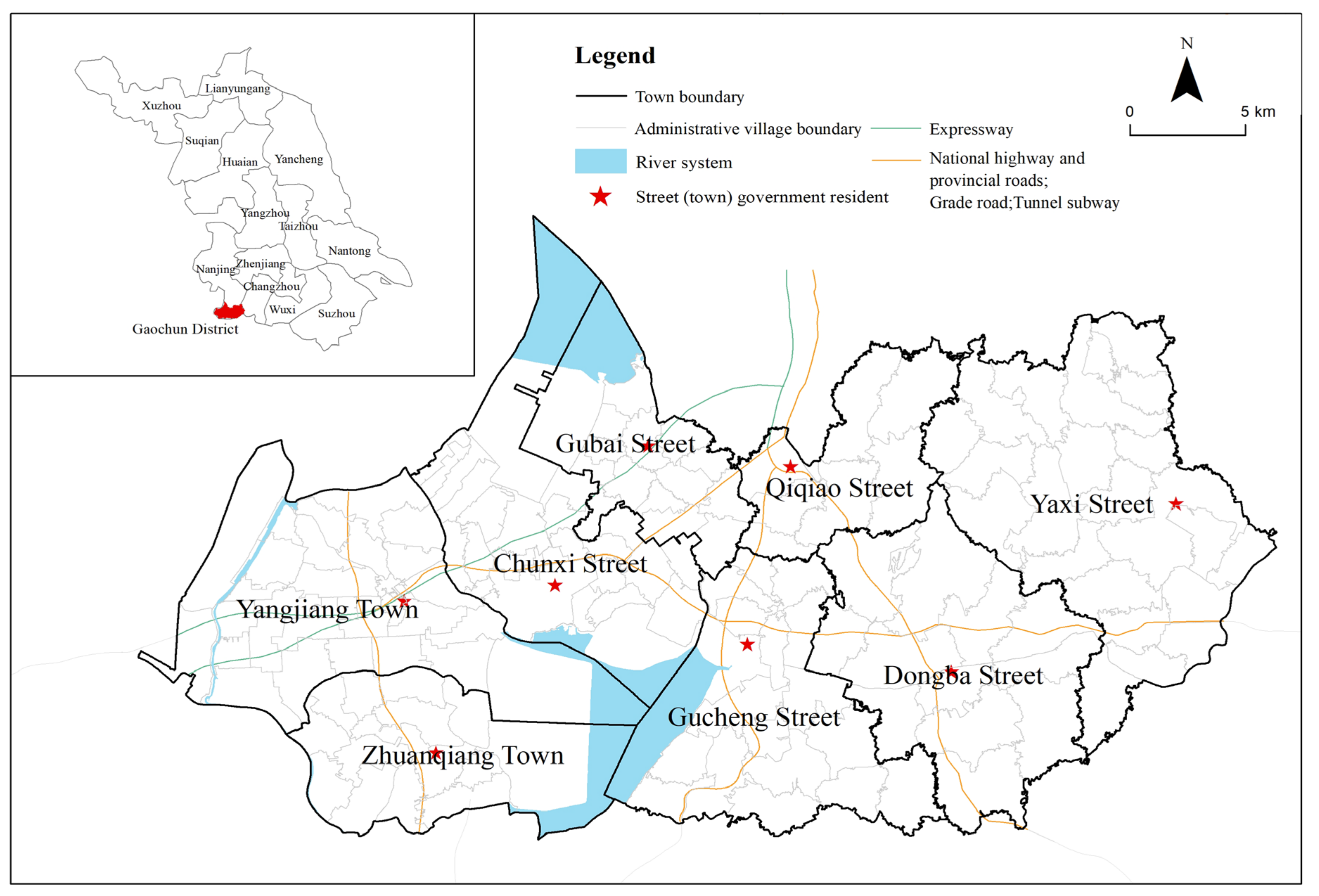
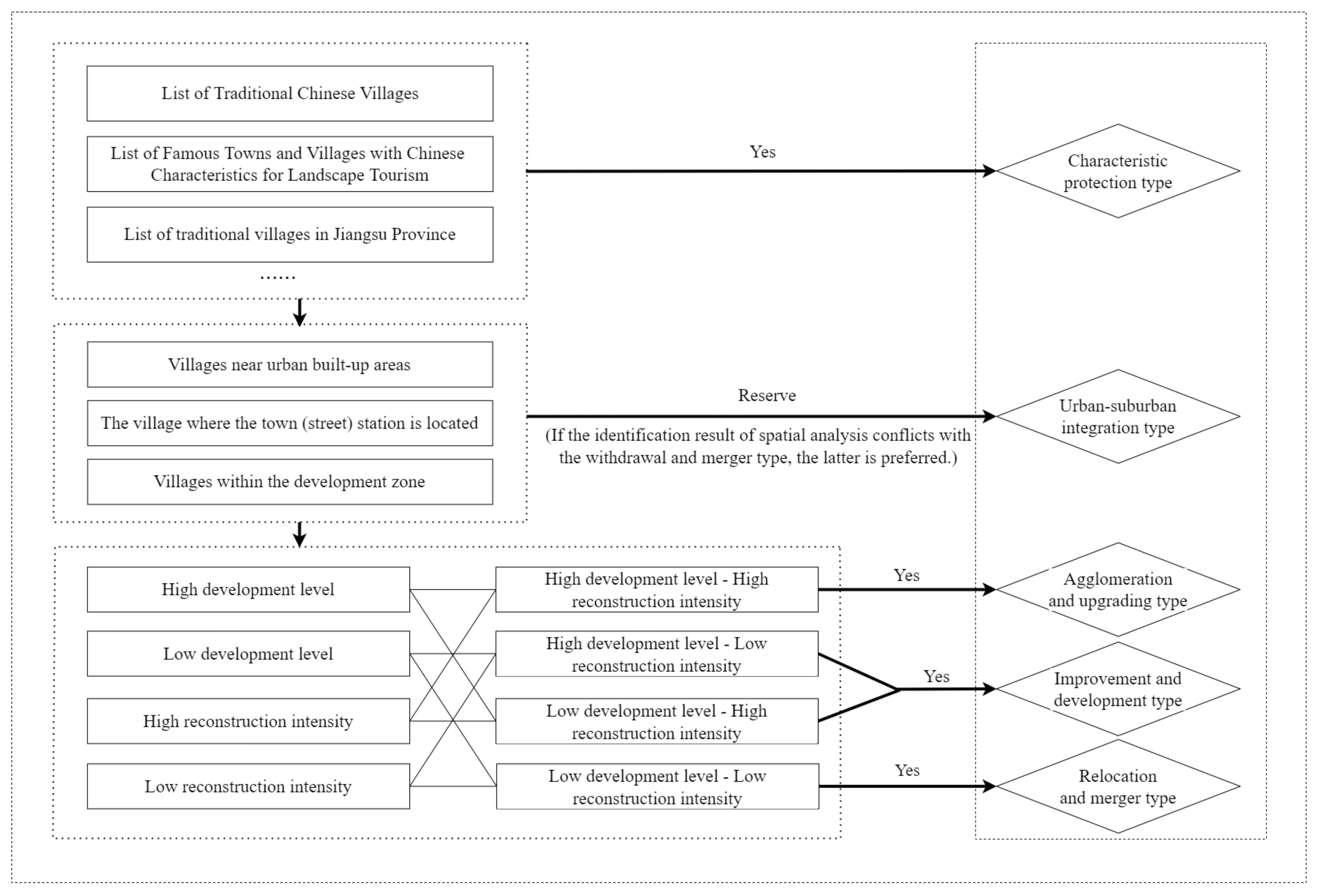


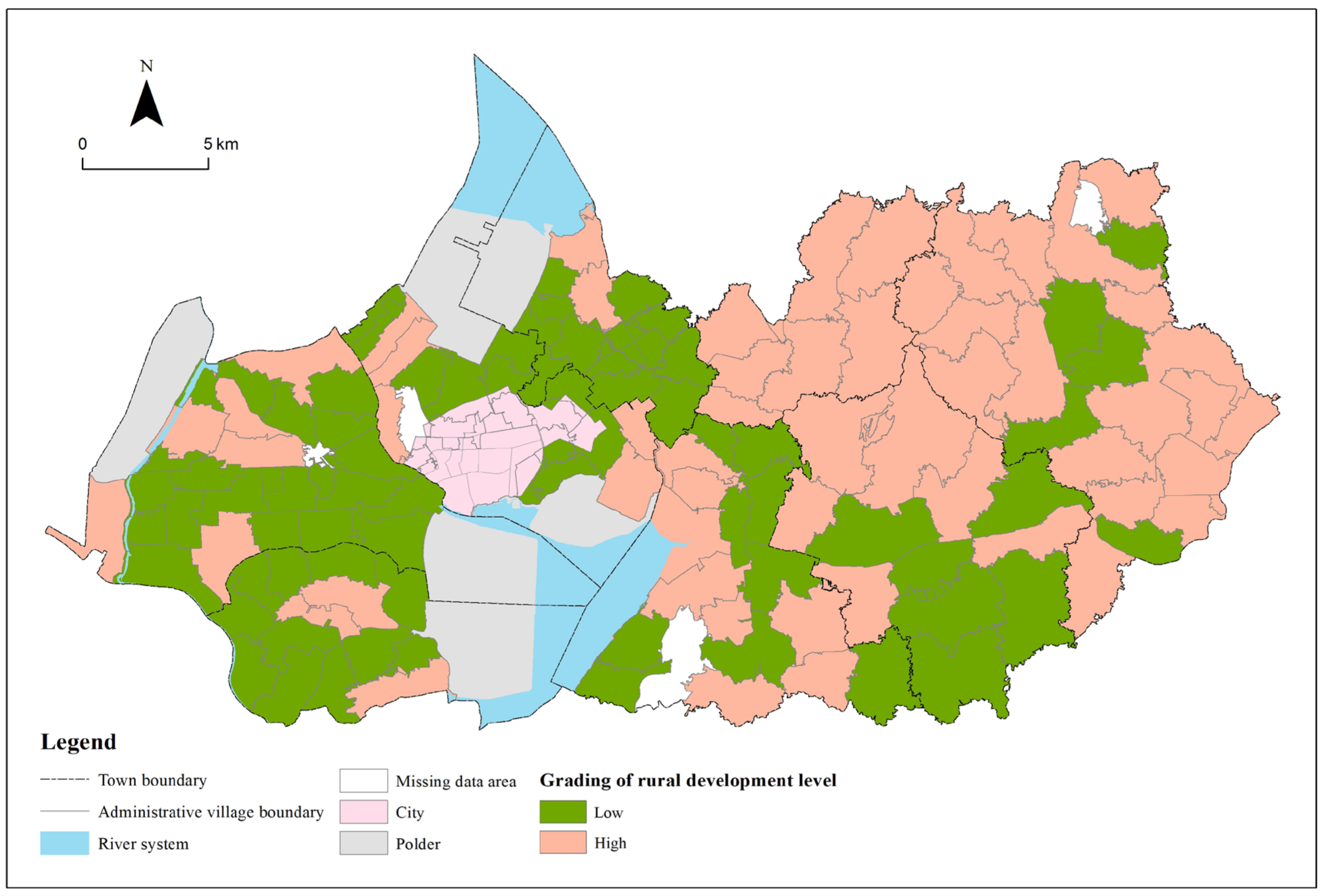
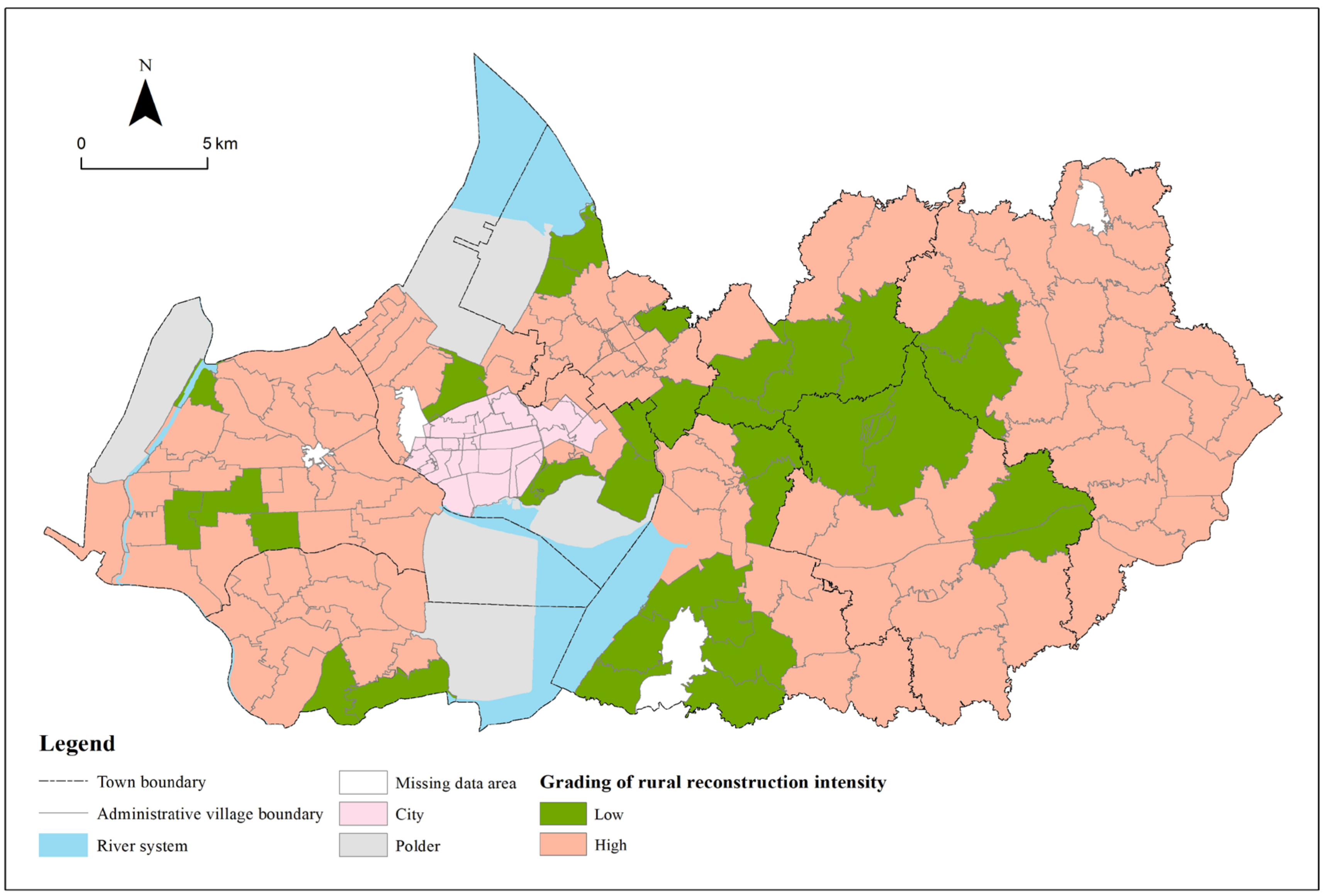
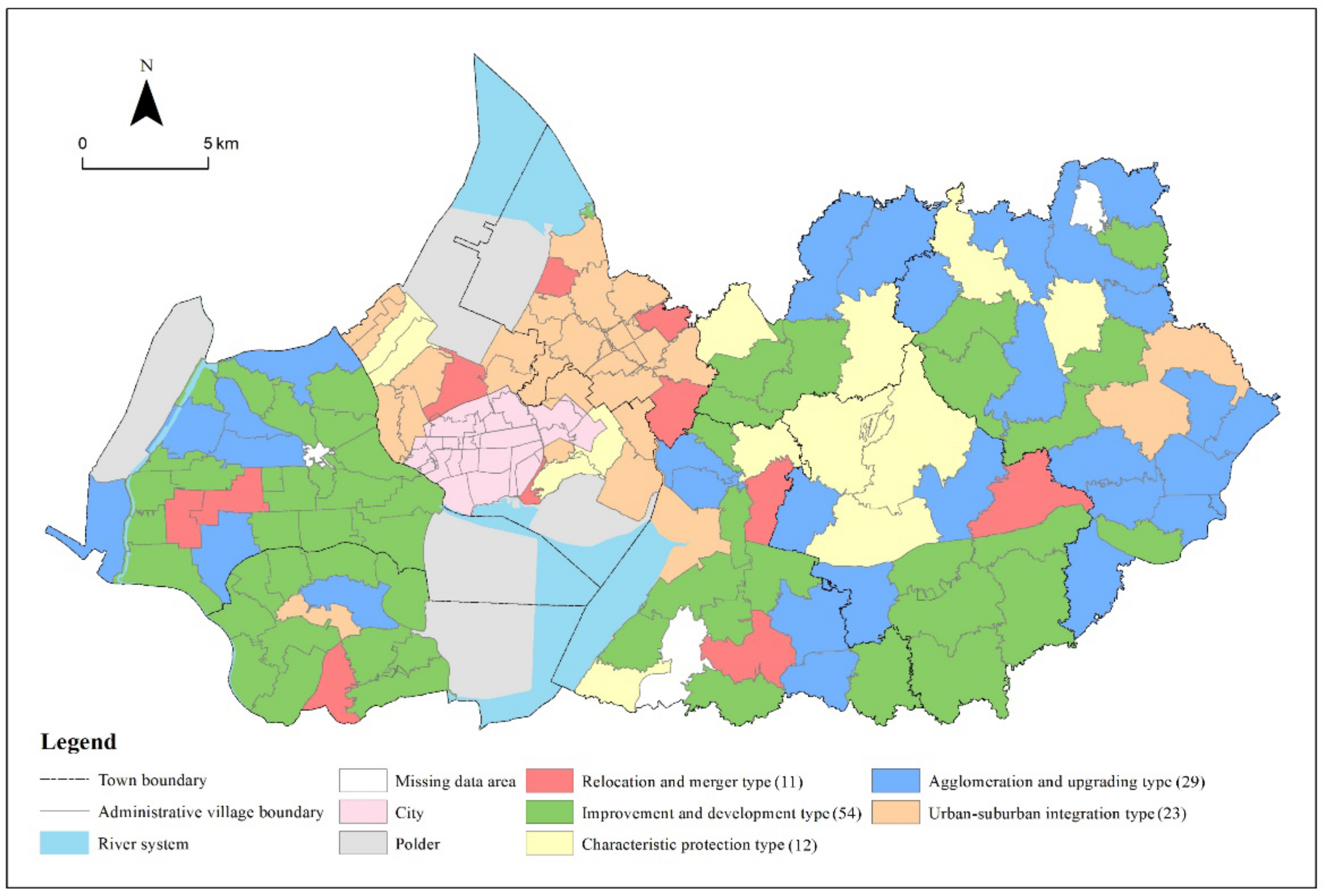
| Target Level | Criterion Level | Index Level | Computing Method | Indicator Attributes |
|---|---|---|---|---|
| Village scale | Population size | Registered residence population | Basic social and economic situation of village in Gaochun District | + |
| Resident population | + | |||
| Land use scale | Village land area | ArcGIS raster computing | + | |
| Homestead per capita | Village land area/resident population | − | ||
| Economic scale | Total collective assets of the village (10,000 yuan) | Basic social and economic situation of village in Gaochun District | + | |
| Annual collective economic income (10,000 yuan) | + | |||
| Geographic conditions | Macro-location | Distance to district government station | ArcGIS raster computing | − |
| Micro-location | Distance to town (street) government | − | ||
| Industrial Development | Agricultural production | Facility agriculture scale | Basic social and economic situation of village in Gaochun District | + |
| Cultivated land area under large-scale operation | + | |||
| Breeding pit and pond area | + | |||
| Number of irrigation ponds and reservoirs | + | |||
| Three-industry integration | Number of agricultural products processing enterprises | + | ||
| Number of farmers selling agricultural products online | + | |||
| Number of farmers with business license engaged in leisure agriculture and rural tourism | + | |||
| Income level | Per capita disposable income of villagers | + | ||
| Natural resources | Resource endowment | Per capita arable land | Village cultivated area/registered residence total population | + |
| Ecological environment | Forest coverage rate | Village forest land area/administrative village area | + | |
| Public service | Social security | Proportion of rural special poverty-stricken people | Number of rural poor/total number of registered residences | + |
| Public utilities | Public infrastructure level | Types of public infrastructure/survey facilities | + | |
| Proportion of running water users | Number of running water users/number of registered residence | + | ||
| Proportion of sanitary toilet users | Number of toilet users/the number of registered households | + |
| Target Level | Criterion Level | Index Level | Indicator Attributes | Computing Method | Weight |
|---|---|---|---|---|---|
| Village scale | Population size | Population migration rate | + | Resident population/registered residence population | 0.106 |
| Proportion of people left behind | − | Left behind population/registered residence population | 0.027 | ||
| Land use scale | Homestead changes per capita | − | Difference value of per capita homestead value between the two phases | 0.042 | |
| Economic scale | Changes in total village collective assets | + | Difference value between total collective assets of villages in two phases | 0.106 | |
| Industrial Development | Agricultural production | Changes in the number of ponds and reservoirs for irrigation | + | Difference value between the number of ponds and reservoirs for irrigation in the two phases | 0.087 |
| Three-industry integration | Number of new business entities | + | Basic social and economic conditions of the village in Gaochun District | 0.287 | |
| Natural resources | Resource endowment | Changes in per capita arable land | + | Difference value of per capita cultivated land area between the two periods | 0.096 |
| Ecological environment | Change in forest cover | + | Difference value of forest coverage between two periods | 0.076 | |
| Planned ecological location | − | Ecological red line buffer zone | 0.173 |
| Target Level | Index Level | Weight | ||
|---|---|---|---|---|
| AHP | Entropy Weight Method | Combination Method | ||
| Village scale | Registered residence population | 0.055 | 0.008 | 0.038 |
| Resident population | 0.057 | 0.007 | 0.036 | |
| Village land area | 0.027 | 0.092 | 0.051 | |
| Homestead per capita | 0.075 | 0.016 | 0.053 | |
| Total collective assets of the village (10,000 yuan) | 0.106 | 0.104 | 0.105 | |
| Annual collective economic income (10,000 yuan) | 0.036 | 0.001 | 0.023 | |
| Geographic conditions | Distance to district government station | 0.050 | 0.109 | 0.072 |
| Distance to town (street) government | 0.073 | 0.025 | 0.055 | |
| Industrial Development | Facility agriculture scale | 0.038 | 0.075 | 0.052 |
| Cultivated land area under large-scale operation | 0.058 | 0.150 | 0.093 | |
| Breeding pit and pond area | 0.034 | 0.237 | 0.111 | |
| Number of irrigation ponds and reservoirs | 0.185 | 0.007 | 0.118 | |
| Number of agricultural products processing enterprises | 0.116 | 0.018 | 0.079 | |
| Number of farmers selling agricultural products online | 0.063 | 0.080 | 0.070 | |
| Number of farmers with business license engaged in leisure agriculture and rural tourism | 0.027 | 0.071 | 0.044 | |
| Per capita disposable income of villagers | 0.055 | 0.008 | 0.038 | |
| Natural resources | Per capita arable land | 0.057 | 0.007 | 0.036 |
| Forest coverage rate | 0.027 | 0.092 | 0.051 | |
| Public service | Proportion of rural special poverty-stricken people | 0.075 | 0.016 | 0.053 |
| Public infrastructure level | 0.106 | 0.104 | 0.105 | |
| Proportion of running water users | 0.036 | 0.001 | 0.023 | |
| Proportion of sanitary toilet users | 0.050 | 0.109 | 0.072 | |
Publisher’s Note: MDPI stays neutral with regard to jurisdictional claims in published maps and institutional affiliations. |
© 2022 by the authors. Licensee MDPI, Basel, Switzerland. This article is an open access article distributed under the terms and conditions of the Creative Commons Attribution (CC BY) license (https://creativecommons.org/licenses/by/4.0/).
Share and Cite
Dai, L.; Qiao, W.; Feng, T.; Li, Y. Research on Village Type Identification and Development Strategy under the Background of Rural Revitalization: A Case of Gaochun District in Nanjing, China. Int. J. Environ. Res. Public Health 2022, 19, 6854. https://doi.org/10.3390/ijerph19116854
Dai L, Qiao W, Feng T, Li Y. Research on Village Type Identification and Development Strategy under the Background of Rural Revitalization: A Case of Gaochun District in Nanjing, China. International Journal of Environmental Research and Public Health. 2022; 19(11):6854. https://doi.org/10.3390/ijerph19116854
Chicago/Turabian StyleDai, Lingling, Weifeng Qiao, Ting Feng, and Yuanfang Li. 2022. "Research on Village Type Identification and Development Strategy under the Background of Rural Revitalization: A Case of Gaochun District in Nanjing, China" International Journal of Environmental Research and Public Health 19, no. 11: 6854. https://doi.org/10.3390/ijerph19116854
APA StyleDai, L., Qiao, W., Feng, T., & Li, Y. (2022). Research on Village Type Identification and Development Strategy under the Background of Rural Revitalization: A Case of Gaochun District in Nanjing, China. International Journal of Environmental Research and Public Health, 19(11), 6854. https://doi.org/10.3390/ijerph19116854






